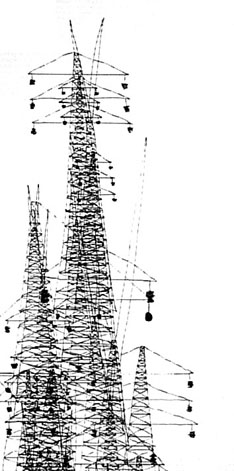

These spaces of land are not viewable in terms of landscape, they a part of the land, but do not embody it. In the way that no man’s land exists, these pylons are parasitic places. The electric wire that is always here to ruin the photo. Being in contact with these metallic structures, the countryside loses its quality of beauty to become a place full of parasites and therefore empty and lacks interest.
They should be taken off the map.
So I went to meet them. Their imposing presence transforms them into giants. The wires extend them further out of the camera’s range and reinforces the idea of the out of frame.
Back in the workshop, these photographs begin a new life. They are not documents as they do not need to attest to reality. We have all seen these places, we have all passed by them and seen them without looking. I have simply taken them out of their natural habitat. Now, they should have purpose.
A thin thread placed randomly comes to disrupt the legibility. This mechanic stroke leaves room for chance, for the rhythm of the hand, the ink, and the breath. It becomes time as much as space, resembling that of a partition with its notes but also and perhaps most importantly with its moments of silence.
Drawing has this aspect of breath, a time where the mental projection can test the limits of movement but also the strong form of the thought process. Like a sediment with the geological stratum, it is with time that drawing shows its orientation and meaning. Curiously, this work on time and slowness has something bewitching to it and distinguishes itself completely from the notion of patience. Things must come together, a sort of improvisation of a theme. Perhaps it’s not due to chance then if I feel more and more a derivation to music. Phil Glass and repetitive music, the search for the electro-acoustic music of Luc Ferrari or of Nils Petter Molvaer, and more recently the discovery of the string quartet of Henrick Goreski.
Whatever it may be, exploration gives way to a path. There is the time of the photograph that allows this necessary marking into reality and the extrapolation of the drawing that allows a direct inscription of the idea in relation to the expertise of the creative process. The drawing represents a passage between two photographic stages, the drawing and the photography build and destroy and the same time, one taking from the other and leaving its trace, but it seems that a new layer has been left and a new door has been opened from my direct confrontation of these two mediums, the photo-graphy.

After the series “Radios Actives” based on the nuclear power plant of Bugey, the “City Lights” with the pylons little by little establishes itself as the link between the power plant’s source and civilization. There was firstly a gallery of “portraits”. It was the beginning of a new story, of a new exploration. These overhead power lines, this construction with no aesthetically pleasing features, skeletons lacking human activity and placed there, cross the country. They span far and across the vast lands, hills and valleys, in a chain, for one, alone, is good for nothing. They traverse.
